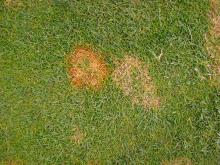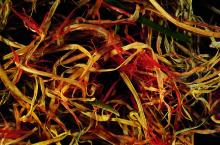Hosts The pathogen can attack all cool-season turfgrasses but is most severe on perennial ryegrass as well as, red and Chewing fescue, and bentgrass to a lesser extent. Hard fescue is resistant.
Cause The disease formerly was known as Corticium red thread and is caused by the fungus Laetisaria fuciformis. Commonly seen in Oregon and Washington, it is primarily cosmetic and rarely kills any grass. Fungi live on diseased grass and in soil. Red thread is more severe on lawns low in vigor. It is typically more severe when nitrogen is limited and alleviated by nitrogen applications. This disease can develop under a wide variety of environmental conditions, however, it is most frequently observed in the fall during periods of humid weather.
Symptoms Circular, irregular yellow patches, 2 to 24 inches, become brown and dead-looking. Affected aerial parts are bound together with a faintly pinkish web. Small, pink or red, horn-like (antler-like) sclerotia of fungus on leaf blades are a sure indication of red thread.
Cultural control This disease can be controlled with cultural practices alone.
- Fertilize with a quick-release nitrogen source at rate of 0.5 to 1.0 lb N/1,000 sq ft.
- Prevent drought stress by using an adequate amount of water based on local growing conditions.
Chemical control Not recommended for home lawns. Focus on cultural control methods. Tolerant strains of many fungal pathogens can be troublesome when one product is used exclusively in a spray schedule. To prevent developing resistant fungi, alternate or tank-mix materials from different groups with different modes of action. Note: Avoid using fungicides containing Group 1 fungicides (such as Cleary's 3336 or OHP 6672) on affected lawns; they can increase the severity of the disease.
- Chipco 26019 FLO at 4 fl oz/1,000 sq ft. Group 2 fungicide. 12-hr reentry.
- Compass 50 WDG at 0.1 to 0.25 oz/1,000 sq ft. Do not use organosilicate additives. Group 11 fungicide. 12-hr reentry.
- Daconil Weather Stik at 5.5 fl oz/1,000 sq ft (curative). Group M5 fungicide.12-hr reentry.
- Disarm 480 SC at 0.18 to 0.36 fl oz/1,000 sq ft. Group 11 fungicide. 12-hr reentry.
- Eagle 20 EW at 1.2 fl oz/1,000 sq ft. May produce a growth regulation effect on Kentucky bluegrass. Group 3 fungicide. 24-hr reentry.
- Fame SC at 0.2 to 0.4 fl oz/1,000 sq ft. Group 11 fungicide. 12-hr reentry.
- Floxcor at 0.27 to 0.36 fl oz/1,000 sq ft plus an adjuvant. Group 11 fungicide. 12-hr reentry.
- Heritage at 0.2 to 0.4 oz/1,000 sq ft. Group 11 fungicide. 4-hr reentry.
- Insignia SC at 0.4 to 0.7 fl oz/1,000 sq ft. Do not use with organosilicate adjuvants. Group 11 fungicide. 12-hr reentry.
- Mancozeb 80% (Fore, Manzate, and Protect DF) at 4 oz/1,000 sq ft. Group M3 fungicide. 24-hr reentry.
- Mirage at 1 to 2 fl oz/1,000 sq ft. Group 3 fungicide. 12-hr reentry.
- Monsoon Turf at 0.6 fl oz/1,000 sq ft. Group 3 fungicide. 12-hr reentry.
- Previa at 2 to 5.5 fl oz/1,000 sq ft. Group M5 fungicide. 12-hr reentry.
- Propiconazole-based products. Group 3 fungicides.
- Banner MAXX at 2 fl oz/1,000 sq ft. 12-hr reentry.
- PropiMax EC at 0.37 fl oz/1,000 sq ft. 12-hr reentry.
- ProStar 70 WG at 1.5 oz/1,000 sq ft. Group 7 fungicide. 12-hr reentry.
- Secure at 0.5 fl oz/1,000 sq ft. Group 29 fungicide. Reentry when sprays have dried.
- Spotrete F at 3.75 to 7.5 fl oz/1,000 sq ft. Group M3 fungicide. 24-hr reentry.
- Tebuzol 3.6F at 0.6 fl oz/1,000 sq ft. Group 3 fungicide. No reentry interval listed.
- Torque at 0.6 to 1.1 fl oz/1,000 sq ft. Do not mix with growth regulators during hot weather as injury may develop. Group 3 fungicide. 12-hr reentry.
- Tourney EZ at 0.37 oz/1,000 sq ft. Do not apply to Poa annua putting greens Group 3 fungicide. 12-hr reentry.
- Trinity at 0.5 to 1 fl oz/1,000 sq ft. Do not mix with growth regulators during hot weather as injury may develop. Group 3 fungicide. 12-hr reentry.
- Velista at 0.3 to 0.5 oz/1,000 sq ft. Group 7 fungicide. 12-hr reentry.
Combination Fungicides
- Armada 50 WDG at 0.6 to 1.5 oz/1,000 sq ft. Do not use a silicone-based surfactant. Group 3 + 11 fungicide. 12-hr reentry.
- Briskway at 0.5 to 1.2 fl oz/1,000 sq ft. Can be used in hot weather. Group 3 + 11 fungicide. Reentry when sprays have dried.
- Concert at 3 to 8.3 fl oz/1,000 sq ft. Do not use on fine fescue turf. Group 3 + M5 fungicide. 12-hr reentry.
- Encartis at 3 to 4 fl oz/1,000 sq ft. Do not use with oil-based pesticides. Group 7 + M5 fungicide. Reentry when sprays have dried.
- Exteris Stressgard at 1.5 to 4 fl oz/1,000 sq ft. Group 7 + 11 fungicide. 12-hr reentry.
- Headway at 1.5 to 3 fl oz/1,000 sq ft. Do not use with silicone-based surfactants or EC formulations. Group 3 + 11 fungicide. 12-hr reentry.
- Heritage Action at 0.2 to 0.4 oz/1,000 sq ft. Group 11 + P1 fungicide. 12-hr reentry.
- Honor at 0.55 to 1.1 oz/1,000 sq ft. Do not use with organosilicone-based adjuvants. Group 7 + 11 fungicide. Golf course turf only.
- Interface at 3 to 4 fl oz/1,000 sq ft. Maintain agitation while spraying. Do not mix with adjuvants. Group 2 + 11 fungicide. 24-hr reentry.
- Lexicon at 0.34 to 0.47 fl oz/1,000 sq ft. Group 7 + 11 fungicide. 12-hr reentry.
- Navicon at 0.7 to 0.85 fl oz/1,000 sq ft. Group 3 + 11 fungicide. 12-hr reentry.
- Pillar G at 3 lb/1,000 sq ft. Group 3 + 11 fungicide. 12-hr reentry.
- Premion at 6 to 8 fl oz/1,000 sq ft. Group 3 +14 fungicide. Reentry when sprays have dried.
- Renown at 2.5 to 4.5 fl oz/1,000 sq ft. Group M5 + 11 fungicide. 12-hr reentry.
- Tartan at 1 to 2 fl oz/1,000 sq ft. Group 3 + 11 fungicide. 12-hr reentry
Reference Bonos, S.A., Wilson, M.M., Meyer, W.A., and Funk, C.R. 2005. Suppression of red thread in fine fescues through endophyte-mediated resistance. Online. Applied Turfgrass Science doi:10.1094/ATS-2005-0725-01-RS.




